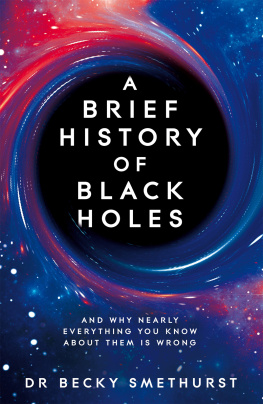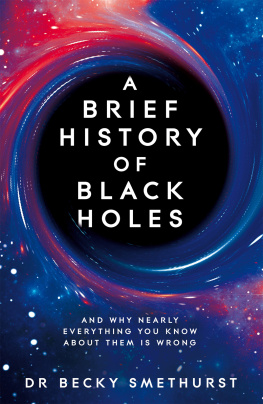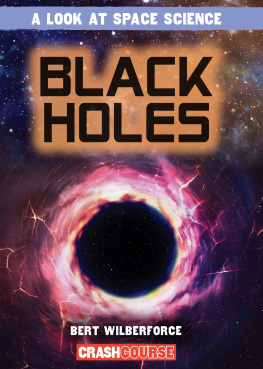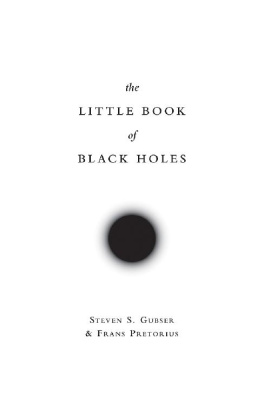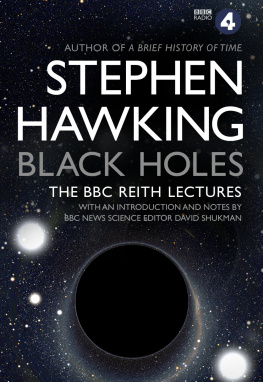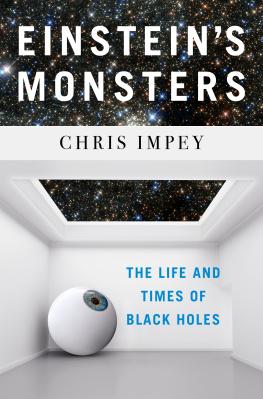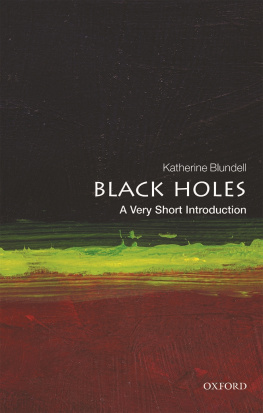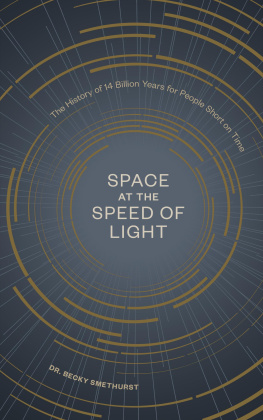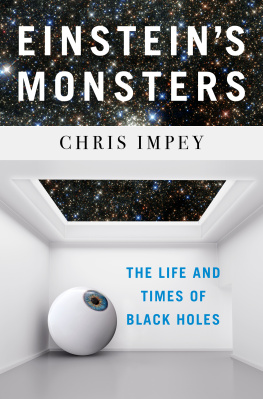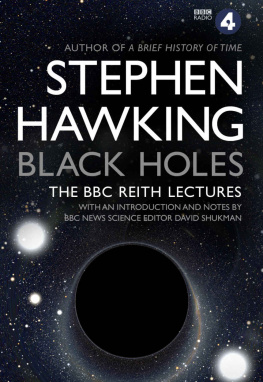Dr Becky Smethurst - A Brief History of Black Holes
Here you can read online Dr Becky Smethurst - A Brief History of Black Holes full text of the book (entire story) in english for free. Download pdf and epub, get meaning, cover and reviews about this ebook. year: 2022, publisher: Pan Macmillan UK, genre: Religion. Description of the work, (preface) as well as reviews are available. Best literature library LitArk.com created for fans of good reading and offers a wide selection of genres:
Romance novel
Science fiction
Adventure
Detective
Science
History
Home and family
Prose
Art
Politics
Computer
Non-fiction
Religion
Business
Children
Humor
Choose a favorite category and find really read worthwhile books. Enjoy immersion in the world of imagination, feel the emotions of the characters or learn something new for yourself, make an fascinating discovery.
- Book:A Brief History of Black Holes
- Author:
- Publisher:Pan Macmillan UK
- Genre:
- Year:2022
- Rating:4 / 5
- Favourites:Add to favourites
- Your mark:
- 80
- 1
- 2
- 3
- 4
- 5
A Brief History of Black Holes: summary, description and annotation
We offer to read an annotation, description, summary or preface (depends on what the author of the book "A Brief History of Black Holes" wrote himself). If you haven't found the necessary information about the book — write in the comments, we will try to find it.
A Brief History of Black Holes — read online for free the complete book (whole text) full work
Below is the text of the book, divided by pages. System saving the place of the last page read, allows you to conveniently read the book "A Brief History of Black Holes" online for free, without having to search again every time where you left off. Put a bookmark, and you can go to the page where you finished reading at any time.
Font size:
Interval:
Bookmark:


To you, and your curiosity that brought you here.
Oh, and to Mum, for always bringing me back down to Earth with a smile.
Contents
A t this very moment, as you sit down and relax to read this book, you are moving at an incredible speed. Earth is currently spinning on its axis, moving us through the relentless march of time from one day to the next. Simultaneously, it is orbiting around the Sun, moving us through the changing of the seasons.
But thats not all. The Sun is just one star in the Milky Way, our galaxy of over 100 billion stars. The Sun is not unique and it is not at the centre. In fact, its fairly average and unremarkable as stars go. The Solar System is contained in a minor (seeing a pattern here?) spiral arm of the Milky Way known as the Orion Arm, and the Milky Way itself is also a fairly generic spiral-shaped island of stars not too big, not too small.
So, this means that along with the speed of the Earth spinning, and the speed of the Earth orbiting the Sun, we are also moving around the centre of the Milky Way at a speed of 450,000 miles per hour. And what do we find at that centre? A supermassive black hole.
Yes right now, you are orbiting a black hole. A place in space with so much material squashed in, that is so dense, that not even light travelling at the fastest speed there is has enough energy to win in a tug-of-war against a black holes gravity, once it gets too close. The idea of black holes has both captivated and frustrated physicists for decades. Mathematically, we describe them as an infinitely dense, infinitesimally small point, surrounded by an unknowing sphere from which we get no light and no information. No information means no data, no data means no experiments, and no experiments means no knowledge of what lies inside a black hole.
As a scientist, the aim is always to see the bigger picture. As we zoom out of our backyard of the Solar System to encompass the whole of the Milky Way, and then even further afield to see the billions of other galaxies across the entire Universe, we find that black holes are always in the gravitational driving seat. The black hole at the centre of the Milky Way, the one currently responsible for your motion through space, is about 4 million times heavier than our Sun; which is why its dubbed a supermassive black hole. While that may sound big, Ive seen bigger. Once again, the Milky Ways black hole is fairly average, relatively speaking. Its not that massive, that energetic, or that active either, making it nearly impossible to spot.
The fact that I can accept those statements as a given, practically taking them for granted every single day, is remarkable. It was only at the end of the twentieth century that we finally realised that at the centre of every galaxy there was a supermassive black hole; a reminder that while astronomy is one of the oldest practices, carried out by ancient civilisations the world over, astrophysics actually explaining the physics behind what astronomers see is still a relatively new science. The advancements in technology throughout the twentieth and twenty-first centuries have only just begun to scratch the surface of the mysteries of the Universe.
Recently, I got wonderfully lost in a sprawling second-hand bookshop and came across a book called Modern Astronomy written in 1901. In the introduction, the author, Herbert Hall Turner, states:
Before 1875 (the date must not be regarded too precisely), there was a vague feeling that the methods of astronomical work had reached something like a finality: since that time there is scarcely one of them that has not been considerably altered.
Herbert was referring to the invention of the photographic plate. Scientists were no longer sketching what they saw through telescopes but recording exactly what was seen onto huge metal plates coated in a chemical that reacted to light. In addition, telescopes were getting larger, meaning they could collect more light to see fainter and smaller things. On page forty-five of my copy, theres a wonderful diagram showing how telescope diameters had increased from a measly ten inches in the 1830s to a whopping forty inches by the end of the nineteenth century. At the time of writing, the largest telescope currently under construction is the Thirty Metre Telescope in Hawaii, which has a mirror to collect light which is, you guessed it, thirty metres across about 1,181 inches in Herberts money, so weve come a long way since the 1890s.
What I love about Herbert Hall Turners book (and the reason I just had to buy it) is that it serves as a reminder of how quickly perspectives can shift in science. There is nothing in the book that I or my colleagues doing astronomy research today would recognise as modern, and I can imagine that in 120 years a future astronomer reading this book would probably think the same. For example, in 1901 the size of the entire Universe was thought to stretch to only the most distance stars at the edge of the Milky Way about 100,000 light years away. We did not know there were other islands of billions of stars, other galaxies, out there in the vastness of the expanding Universe.
On page 228 of Modern Astronomy, theres an image taken with a photographic plate of whats labelled the Andromeda nebula. It is instantly recognisable as the Andromeda galaxy (or perhaps to most people as a former Apple Mac desktop background image). Andromeda is one of the nearest galactic neighbours to the Milky Way, an island in the Universe containing of over 1 trillion stars. The image looks nearly identical to one an amateur astronomer might take from their back garden today. But even with the advancement of photographic plate technology at the end of the nineteenth century, which enabled the first images of Andromeda to be recorded, there wasnt an immediate leap to understanding what it actually was. At the time, it was still dubbed a nebula a fuzzy, dusty, not-star-like thing that was thought to be somewhere in the Milky Way, the same distance away as most stars. It took until the 1920s for its true nature as an island of stars in its own right, millions of light years away from the Milky Way, to be known. This discovery fundamentally shifted our entire perspective on our position in, and the scale of, the Universe. Overnight, our world view changed as the Universes true size was appreciated for the first time. Humans were an even tinier drop in an even larger ocean than we had ever realised before.
The fact that weve only really appreciated the true scale of the Universe for the past 100 years or so is, in my opinion, the best example of how young of a science astrophysics truly is. The pace of advancement in the twentieth century has far exceeded even the wildest dreams of Herbert Hall Turner in 1901. In 1901, the idea of a black hole had barely crossed anyones mind. By the 1920s, black holes were merely theoretical curiosities, ones that were particularly infuriating to physicists like Albert Einstein because they broke equations and seemed unnatural. By the 1960s, black holes had been accepted, theoretically at least, thanks in part to the work of British physicists Stephen Hawking and Roger Penrose and New Zealand mathematician Roy Kerr, who solved Einsteins general relativity equations for a spinning black hole. This led, in the early 1970s, to the first tentative proposal that at the centre of the Milky Way was a black hole. Lets just put that into context for a minute. Humans managed to put someone on the Moon before we could even comprehend that all our lives have been spent inexorably orbiting around a black hole.
Font size:
Interval:
Bookmark:
Similar books «A Brief History of Black Holes»
Look at similar books to A Brief History of Black Holes. We have selected literature similar in name and meaning in the hope of providing readers with more options to find new, interesting, not yet read works.
Discussion, reviews of the book A Brief History of Black Holes and just readers' own opinions. Leave your comments, write what you think about the work, its meaning or the main characters. Specify what exactly you liked and what you didn't like, and why you think so.

